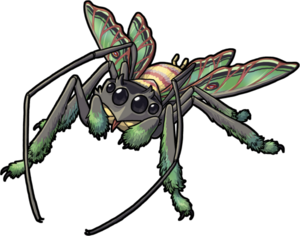Hecking Nope: Difference between revisions
imported>Gathouria m (Added known attacks) |
imported>Gathouria m (Added FRIC number) |
||
| Line 2: | Line 2: | ||
|Species=Hecking Nope | |Species=Hecking Nope | ||
|image=[[File:Hecking_Nope_Adult_Emerald.png|300px]] | |image=[[File:Hecking_Nope_Adult_Emerald.png|300px]] | ||
|FRIC= | |FRIC=34 | ||
|Grouping=Arthropod | |Grouping=Arthropod | ||
|Sector=[[Crop Circle Canyon]] | |Sector=[[Crop Circle Canyon]] | ||
Revision as of 08:18, 22 July 2021
The Hecking Nope is a Very Common creature released on Protochroma. It is found only in Crop Circle Canyon and cannot currently be found in any Delve. Its standard variant is Emerald.
Descriptions
Baby
This egg is rather long, and carefully attached to the underside of a smooth surface by the silk it's wrapped in.
Juvenile
The egg hatched into a fast-moving, active spiderling with underdeveloped wings. It quickly chose a spot high up to build a silk nest. It startles easily, but it seems to be quick to learn what's safe and what isn't, and will climb on you if allowed and touch everything in reach with its thin antenniform legs. It seems to enjoy nectar, but also smaller arthropod prey, and gets quite excited when offered flowers or a dish of sugar water.
Adult
Hecking Nopes were discovered by the first research team sent to Crop Circle Canyon—specifically, when one jumped onto a researcher's face from a flowering succulent-like plant they were inspecting. This same researcher is the one who chose the species name.
Hecking Nopes are a species of winged arachnid that can both jump and fly. They are, however, nonvenomous, and are important pollinators for many of the plant species found in arid climates. Their fluffy legs and abdomens tend to pick up a fair amount of pollen as they travel, and they will opportunistically feed on other invertebrates they find on the plants while searching for nectar, ridding them of pests in the process. They are very curious when not feeling threatened, and will carefully inspect objects—or people—that they find interesting.
Additional Lore
Delving
Images
| Image Type | Images | ||||||
|---|---|---|---|---|---|---|---|
| Baby |  |
-- | -- | -- | -- | -- | -- |
| Juvenile |  |
-- | -- | -- | -- | -- | -- |
| Common Adult |
 |
 |
 |
 |
 |
 |

|
| Rare Adult |
 |
 |
 |
 |
 |
 |

|

